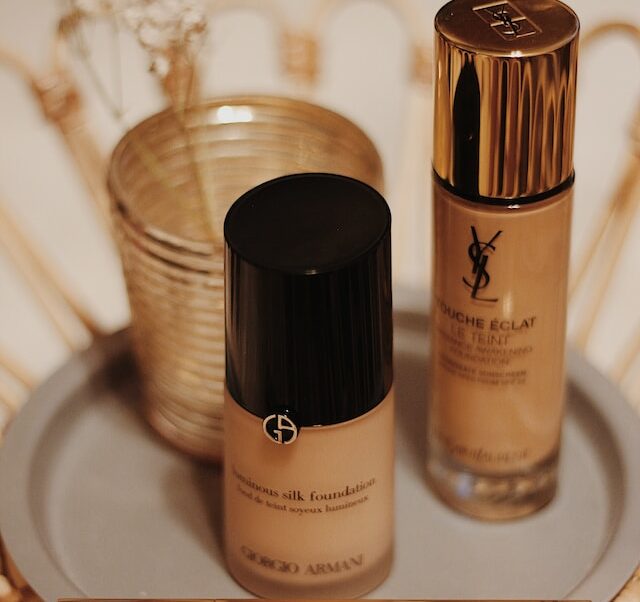Skin tints provide a lighter coverage with added skincare benefits, while foundations offer more coverage but can be heavy on the skin. When choosing between these two products, it’s important to consider your skin type and desired level of coverage. While some people prefer to use one over the other, you don’t necessarily have to choose only one. You can also use both depending on your needs – for example, using a lightweight skin tint for everyday wear and then switching to a full-coverage foundation for special occasions.
What is skin tint?
Skin tint is a lightweight, sheer coverage product that is designed to even out your skin tone while also providing some hydration. Unlike foundation, it’s meant to enhance your natural complexion rather than completely covering it up.
Skin tints usually come in the form of a tinted moisturizer or BB cream and are perfect for those who want a more natural-looking finish. They offer just enough coverage to blur any imperfections without looking too heavy or cakey.
One of the biggest advantages of using skin tint over foundation is that it feels much lighter on the skin. It doesn’t clog pores or suffocate your skin like heavier products can, which makes it ideal for everyday wear.
But keep in mind that because they provide less coverage, you might need additional concealer if you have blemishes or dark circles under your eyes. Skin tints also typically have fewer shade options as they’re designed to blend seamlessly into most complexions.
What is foundation?
(Photo by Karly Jones on Unsplash )

Foundation is a cosmetic product used to even out the skin tone and create a smooth base for makeup. It’s typically available in liquid, cream or powder form and comes in various shades to match different skin tones.
The primary purpose of foundation is to provide coverage, conceal blemishes, dark spots, acne marks and other imperfections on the face. Foundation can also help control oiliness, reduce shine and hydrate dry skin.
There are many types of foundations available today such as matte finish foundation which gives a powdery finish while luminous finish foundation which provides an illuminated glowy look.
To apply foundation correctly, it’s important to use the right tools such as brushes or sponges that will blend it seamlessly with your skin without leaving streaks or patches.
It’s essential to choose the right shade that matches your natural skin undertones; otherwise you may end up looking unnatural.
Foundation is an indispensable tool for anyone who wants flawless-looking complexion as part of their daily beauty routine.
Skin tint Vs. Foundation – Key differences
Skin tint and foundation are two of the most popular makeup products used to enhance one’s complexion. Although they may seem similar at first glance, there are key differences between the two.
One of the main differences is their coverage levels. Skin tints offer a sheer and natural finish, while foundations provide more coverage and can be built up for a fuller look. This makes skin tints perfect for those who prefer a more minimalistic approach to makeup or have relatively clear skin with minor imperfections.
Another difference lies in their formulation. Skin tints typically contain fewer ingredients than foundations and often include skincare properties such as SPF or hyaluronic acid to hydrate and protect the skin throughout the day.
Additionally, application methods differ between skin tint and foundation. While both can be applied using fingers or brushes, many people find that skin tints blend seamlessly into the skin when applied with just fingertips due to their lightweight texture.
When it comes down to choosing between a skin tint or foundation, it ultimately depends on your personal preferences and needs. Consider your desired level of coverage, formulation preferences, and application method before making a decision!
How to choose the right product for your skin type
Choosing the right product for your skin type can be a daunting task, especially with so many options available in the market. However, selecting the correct foundation or skin tint is essential to achieve a flawless and natural-looking complexion.
The first step towards choosing the right product for your skin type is to identify your skin tone and undertone. Skin tone refers to the color of your skin while undertone refers to the subtle hue that lies beneath it. Undertones are usually categorized as warm, cool or neutral.
Once you have identified your skin tone and undertone, consider factors such as coverage level, finish and formula when selecting between foundation and skin tint products. For instance, if you have oily or combination skin opt for matte finishes while those with dry or matured one should go for dewy formulas.
Another important factor to consider is pigmentation concerns such as acne scars, dark circles under eyes etc., which may require higher coverage levels than usual. Consider using buildable formulas like BB creams which allow you control over how much coverage you want.
Ultimately it’s important that whichever product you choose works well with both your skincare routine and personal preferences; this will ensure maximum effectiveness in providing an even-toned appearance throughout wear-time
Can skin tint replace foundation?
Skin tint and foundation have similar purposes, which is to even out the skin tone and provide coverage. However, many people wonder if they can replace their foundation with a skin tint product.
The answer really depends on your individual preferences and needs. Skin tints are generally lighter in coverage than foundations, so if you have major blemishes or unevenness that you want to cover up completely, then a skin tint may not be enough for your needs.
On the other hand, if you prefer a more natural look or don’t need full coverage on a daily basis, then a skin tint could be an excellent option for you. Skin tints often contain less heavy pigments than traditional foundations and instead rely on light-reflecting particles to blur imperfections while still allowing some of your natural beauty to shine through.
Ultimately, it comes down to personal preference – some individuals may find that using both products together provides them with optimal results while others might choose one over the other depending on their mood or occasion.
The pros and cons of skin tint
Skin tint is a popular makeup product that offers light coverage and a natural finish. Like any other beauty product, it has its advantages and disadvantages.
One of the major pros of skin tint is that it’s lightweight and easy to apply. It blends seamlessly into the skin, providing a sheer layer of coverage without feeling heavy or caked-on. It’s also great for those who want to achieve a “no-makeup” look while still evening out their complexion.
Another advantage of skin tint is that it often contains moisturizing ingredients such as hyaluronic acid or glycerin, which can help hydrate the skin throughout the day. This makes it an ideal choice for those with dry or dehydrated skin.
On the flip side, one potential con of using a skin tint is that it may not provide enough coverage for those with more significant blemishes or discoloration on their face. In these cases, you may need to layer on additional concealer or foundation to achieve your desired level of coverage.
Additionally, some people may find that certain formulas of skin tints can be too oily or greasy for their liking, leading to unwanted shine throughout the day. This can be mitigated by setting your makeup with powder or choosing oil-free options specifically formulated for oily complexions.
The pros and cons of foundation
Foundation is a popular makeup product used to create an even skin tone and cover blemishes. It comes in various forms such as liquid, powder, cream or stick. Like any other beauty product, foundation also has its own set of pros and cons.
One of the biggest advantages of foundation is that it provides full coverage for all types of skin blemishes such as dark spots, acne marks or discoloration. Another benefit is that it helps to control oil production on oily skin types while providing a matte finish.
Foundation also comes in many shades and formulas making it easy to find one that matches your unique complexion. Plus, with advancements in technology there are now foundations available with added skincare benefits such as SPF protection and anti-aging ingredients.
On the downside, some people may experience clogged pores or breakouts when using certain types of foundation due to their heavy formulation. Additionally, if not applied properly it can look cakey or heavy on the face which can make you appear older than you actually are.
Another disadvantage is that it requires proper removal at night time to prevent further breakouts and ensure healthy skin. While there are many affordable options available on the market today but high-end brands can be quite pricey making them unaffordable for some individuals.
Foundation has both positive aspects along with negative ones so choosing what works best for your needs should be based on your individual preferences and requirements rather than solely relying on others’ opinions.
Featured Image By – Elena Pashynnaia from Pixabay









